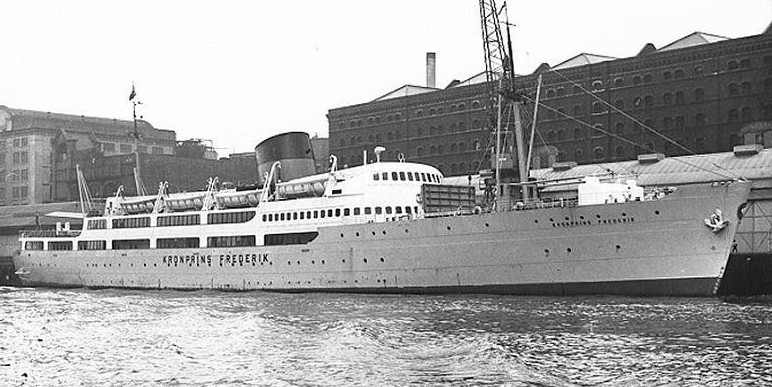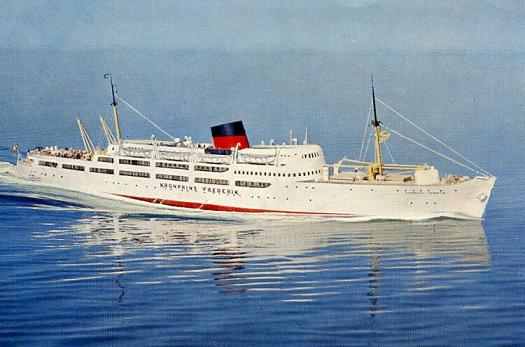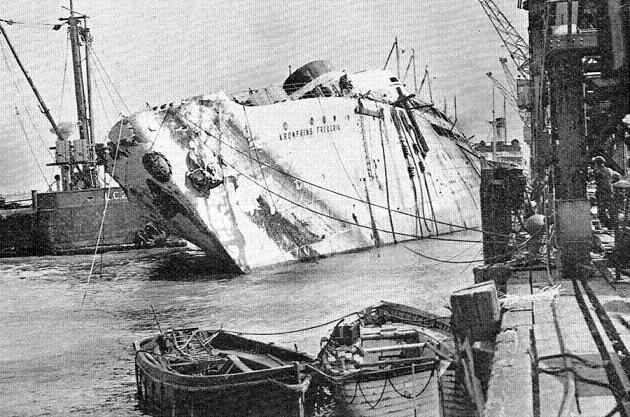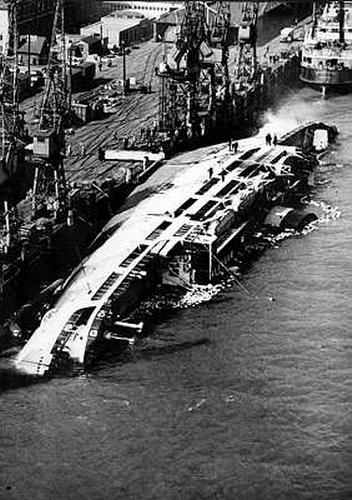One item of note is that the ship was upgraded with a radar system in September-October 1946, a DECCANavigation System provded by Metropolitan Vickers Electrical Export Co. Ltd. (Metrovick), one of the first Danish ships to be outfitted with radar equipment.
On 19 April 1953, The ship arrived at Harwich after making passage from Esbjerg, Denmark and moored at Parkeston Quay. Soon after the passengers had disembarked a fire broke out in one of the passenger cabins. Firefighting efforts by the ship’s crew were unable to control the fire. Local firefighting brigades arrived and provided additional assistance, however, the fire continued to rage out of control. Four local firefighters and two of the crew were injured while attempting to fight the fire. At 2200 that evening, the ship began to sink, with still over one-third of the ship in flames. At approximately 0500 the following morning, 20 April, the ship began to roll over on her starboard side. The ship’s fuel-oil tanks had ruptured, leaking fuel oil into the water surrounding the ship which soon caught fire. When the lines holding the ship to the pier finally broke, the ship came to rest on her starboard side with her keel parallel to the pier. The ship was declared a total constructive loss by the insurers.
The ship’s owners, DFDS, were not about to give up on the ship and the company was able to purchase the ship from the insurer. The ship was salvaged and raised on 26 August 1953, and after a week of pumping water out of the ship, temporary repairs were conducted in order to keep the ship afloat. The ship was then towed on 13 September to Helsingör, Denmark, arriving on the 18th, for permanent repair.
Upon completion of repairs at Helsingör, the ship was returned to its owners on 23 April 1954. Soon afterwards, on 07 May, the Kronprinz Frederik was returned to service on the Esbjerg-Harwich route where the ship provided reliable service until 1963 when the ship was leased out for private charter to the Carlsberg Distribution Co., Ltd., London, England for a passage departing from Harwich on 22 May 1963 and sailing to Oslo, Norway, then on to Copenhagen, Denmark, returning to Harwich on 29 May.
The ship was again chartered by Carlsberg Distribution Co., Ltd. in September 1963. Departing Harwich, England on 17 September and sailing again to Oslo, arriving on 18 September. The Kronprins Frederik departed Oslo on 20 September and arrived at Copenhagen on the 21st, departing on 23 September and returned to Harwich on the 24th of that month via the Kiel Canal. After discharging the passengers she then sailed to Esbjerg on the same day without passengers.
From 26 June to 13 September 1964, the
Kronprins Frederik provided service on the Esbjerg/Newcastle route.
On 24 May 1965 the ship was under private charter to the Kunglia Royal Automobile Club, Stockholm, Sweden, departing Copenhagen on the 24th and sailing for Stockholm, then to Leningrad, Russia, and returned to Copenhagen on 01 June 1965.
The
Kronprins Frederik departed Copenhagen on 02 June 1965, possibly under private charter again, and made passage to Leith, England; Newcastle, returning to Esbjerg on 08 June 1965.
The ship was reassigned to the Ebsjerg/Harwich route again from 09 June 1965 until 11 or 12 September.
At some point during that same year, 1965, the ship was upgraded with bow thrusters and anti-roll tanks.
15 January 1966 finds the Kronprins Frederik assigned to the Copenhagen and Torshavn, Klagsvig, Trangisvaag (all in the Faroe Islands), and Reykjavik, Iceland before being returned to the Esbjerg/Newcastle route and providing service on that route from 10 June until 11 September 1966. Soon thereafter, the ship was returned to the Copenhagen/Torshavn/Klafgsvig/Trangisvaag/Reykjavik route where she would continue providing passenger service until 1971. On 05 October 1970, port calls at Reykjavik were discontinued.
During the year 1971 the
Kronprins Frederik was modified in order to carry only one passenger class.
02 May 1972 found the ship sailing on the Ebsjerg/Torshavn/Trangisvagg service route until the summer season of that year when the port of Newcastle was added to the route. She would continue sailing on this service route until 09 July 1974 when she made her last port call at Ebsjerg from Newcastle, was taken out of service, laid up in Ebsjerg, and put up for sale.
On 10 March 1976, the Kronprins Frederik was purchased by the Arab Navigation Company, Suez, Egypt, taking possession of the ship on 16 March and was renamed as the M/V Patra.

The Loss of the M/V Patria
On 23 or 24 December 1976, the
Patra departed Jeddah, Saudi Arabia on passage to Suez, Egypt with 353-387 passengers and 88-94 crew onboard. Many of the passengers were pilgrims returning from Muslim holy sites of Mecca and Medina, others were Egyptian workers from Saudi Arabia returning home with money and gifts for their families.
There is quite a bit of conflicting information concerning the ship’s loss, but is known that a fire broke onboard in the ship’s engine room which, according to some reports, was followed by a series of explosions. One survivor’s account states that they (the passengers) were ordered to jump overboard after the first explosion. Fire fighting efforts by the ship’s crew proved ineffective and it was later determined that the fire fighting equipment was obsolete and in poor condition. It is known that the order to abandon ship was given, with the captain, Mohammed Hammed, later stating that he and the crew had to chase many of the passengers off the sinking ship with axes because they refused to leave their baggage and possessions onboard. Other survivors also stated that the crew of the ship were among the first to man the lifeboats which were said to have been full of holes.
As the passengers and crew were abandoning the ship, half a dozen passing ships came to their rescue, picking many of the people in the water and lifeboats, with the Russian tanker Lenino rescuing the captain and 201 of the survivors. The Patra, still in flames, sank a few hours later on the early morning of 25 December 1976 at position 21.56N / 38.28E in over 450 meters of water. Of the passengers and crew onboard, 102 lives were lost……
References:
Miramar Ship Report for 5196983
http://research.dnv.com/skj/Fsahla/Annex1.pdf#8
http://www.faktaomfartyg.se/kronprins_frederik_1941.htm
http://www.kwmosgaard.dk/ferries/kronprinsfrederik_1941.htm
http://www.faergelejet.dk
http://timelines.ws/subjects/Disasters.HTML
http://www.timelinesdb.com
http://www.emergency-management.net/ship_acc.htm
“The Straits Times”, Page 3, Singapore (25 April 1953)
“The Bulletin”, Page 8, Bend, Deschutes County, Oregon (28 December 1976)
“The News and Courier”, Page 2A, Charleston, S.C. (27 December 1976)
“Lundington Daily News” ,Ludington Michigan (27 December 1976)
“The Spokesman-Review”, Spokane, Washington (26 December 1976)







1 Comment
Leith is in Scotland, not England,